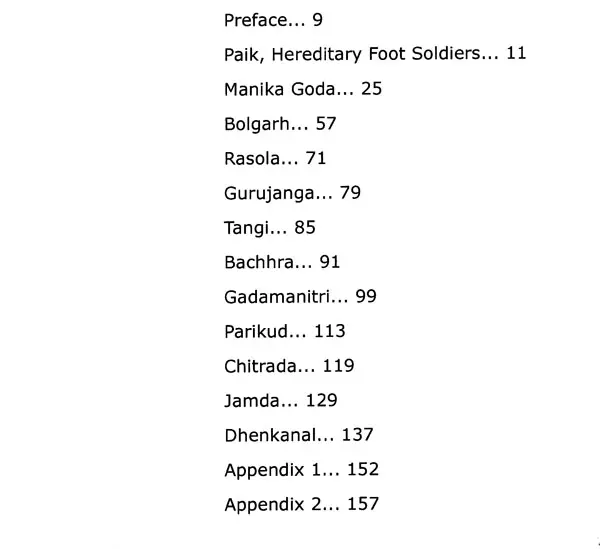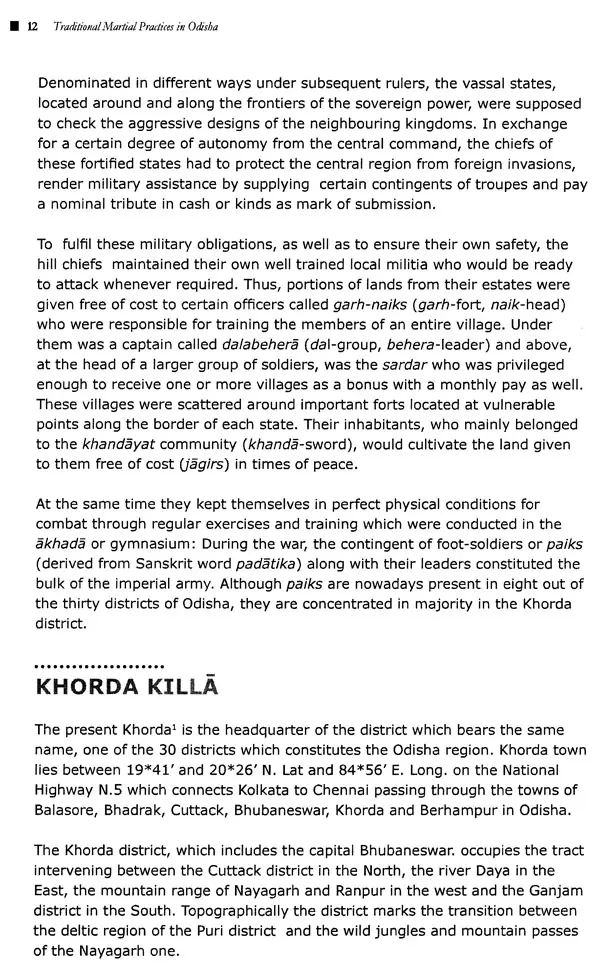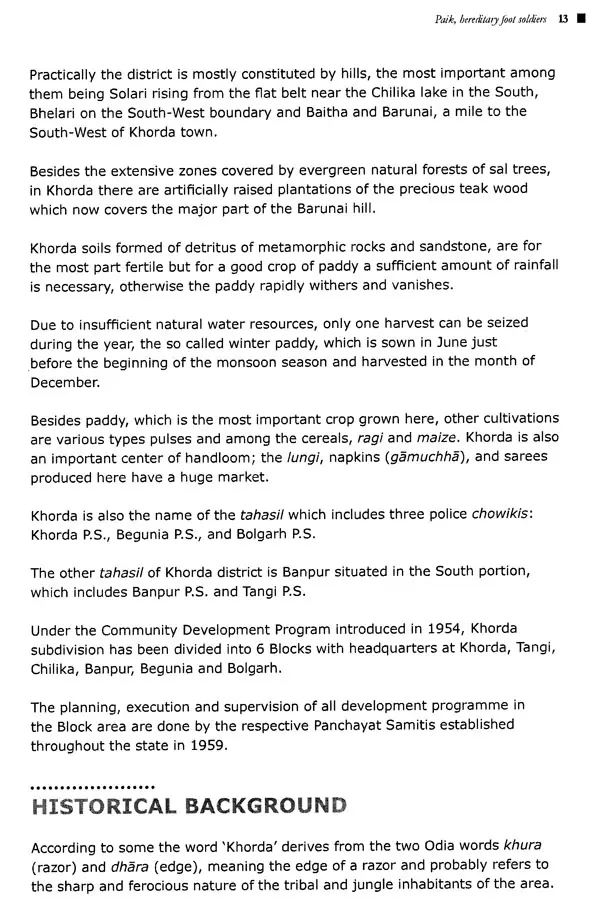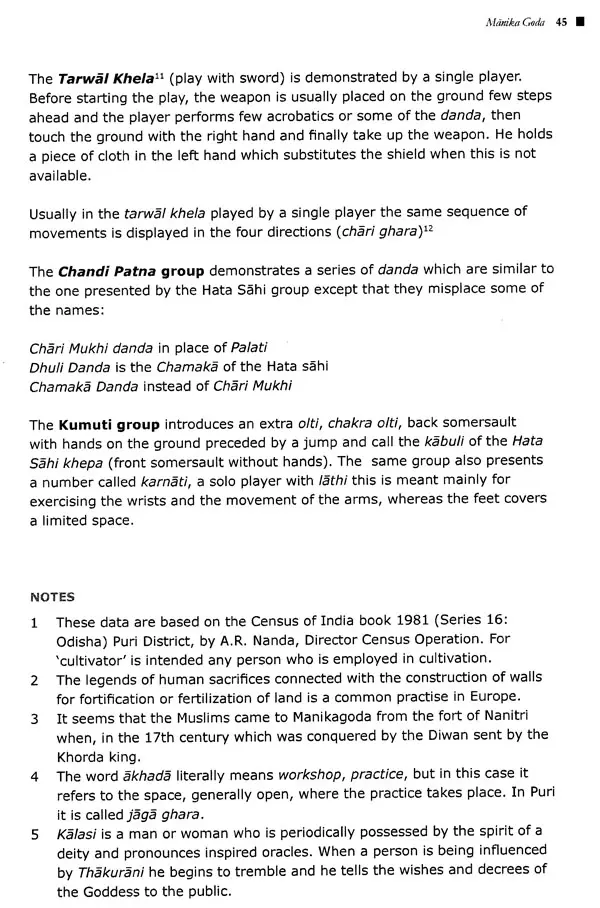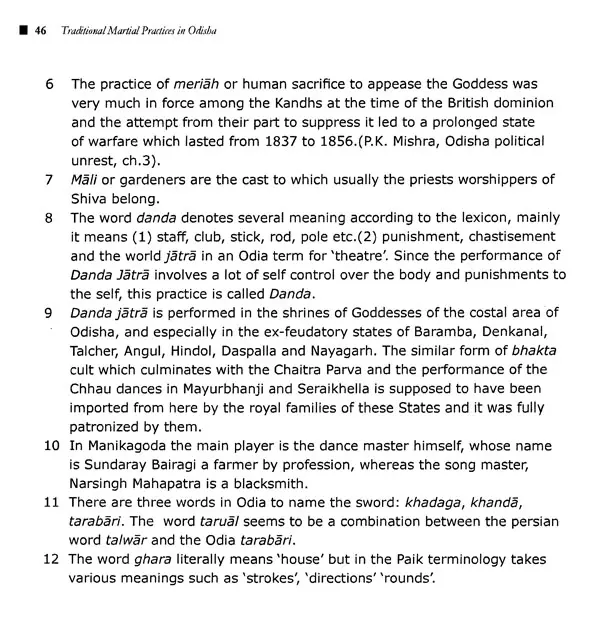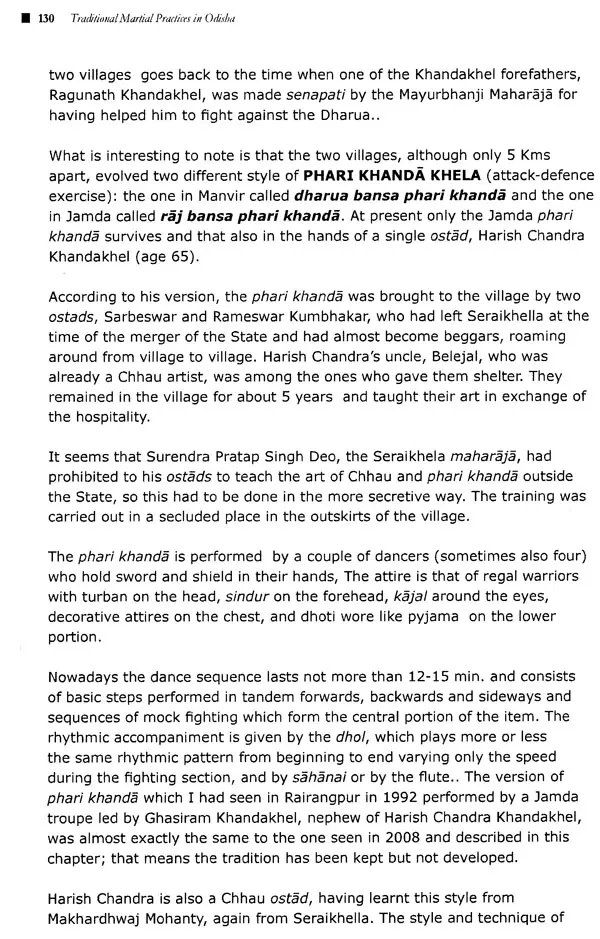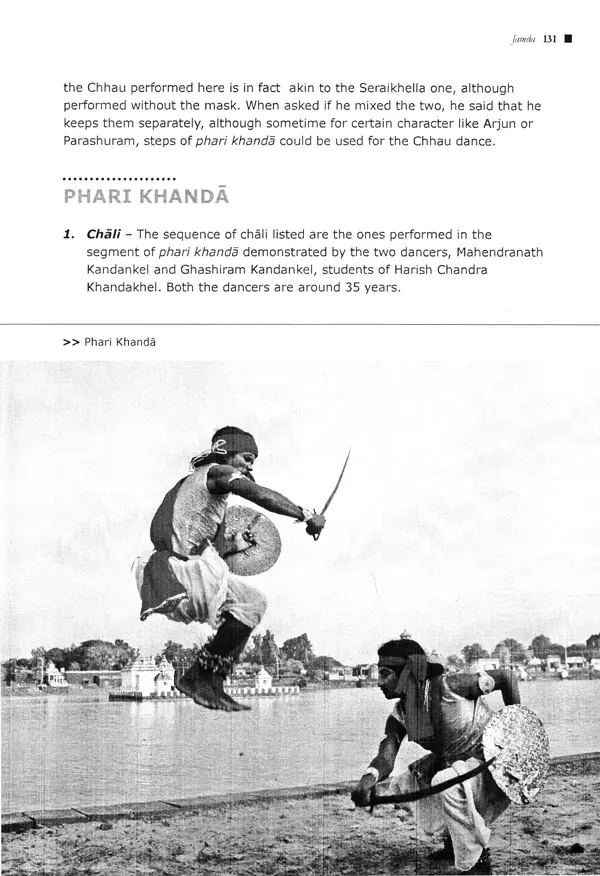
Traditional Martial Practices in Odisha
Book Specification
| Item Code: | UAE300 |
| Author: | Ileana Citaristi |
| Publisher: | Shubhi Publications, Gurgaon |
| Language: | English |
| Edition: | 2012 |
| ISBN: | 9788182901353 |
| Pages: | 159 (Throughout B/W Illustrations) |
| Cover: | HARDCOVER |
| Other Details | 11.00 X 8.00 inch |
| Weight | 710 gm |
Book Description
The book by the celebrity danseuse Padmasree, Ileana Citaristi vividly captures the martial arts of Odisha, specially the Paik dance of a bygone era, when Paiks (derived from padatik) infantry foot soldiers of the then kalinga (the ancient name of Odisha) kept themselves in war-readliness by rigorously practicing the armed and unarmed combat styles. The book is all about such forgotten stories of valor, the skills developed with of without the swords and spears, all for the sake of protecting the motherland, the highest form of dedication and sacrifice, which is faithfully portrayed by the dancer-writer. Interwoven with the martial art fomr are the rituals, the code of ethics and the religious practices which are still being practiced in the districts of Odisha. The book will give the reader an insight into these seemingly innocuous practices but suffused with folklores and associated with historical events that speak volumes of the heroism of the hereditary foot soldiers.
Meticulously researched and well documented the book provides a wealth of information and can be valuable reference material to any student of history, culture and art forms. Here is a dancer who is occidental by birth, belongs to a distant land but holds a lens to the glorious history of the oriental, through its indigenous martial art forms and thereby scripts a tale of the ordinary Paiks but extraordinary brave foot soldiers of medieval.
Italian by birth, Padmashree Dr. Ileana Citaristi holds a Doctorate in Philosophy with a thesis on 'Psychoanalysis and eastern mythology'. She has come to Indian dance after years of experience in the traditional as well as experimental theatre in Europe.
Ileana has been living in Orissa, India, since the year 1979. Her mentor in the Odissi dance style is Padma Vibhushan Kelucharan Mohapatra. She is equally at home with the Chhau dance of Mayurbhanji which she has learnt under the guidance of Guru Shri Hari Nayak.
She has given performances in all the major dance festivals in India as well as in Italy, Argentina, Poland, France, Germany. Holland, Denmark, Malaysia, Hong Kong, Japan, USA, Australia, Israel, Spain, Poland. South Korea and Canada.
In May 1996 she won the 'National Award for best choreography' for her dance direction to the Bengali film 'Yugant' directed by Aparna Sen. She wrote a book on Kelucharan Mohapatra's life 'The making of a guru which was published in the year 2001. In 2006 she has been awarded with the title of Padmashree for her contribution to Odissi dance.
In Bhubaneswar she is imparting training in Odissi and Chhau in her own institution 'Art vision', founded in the year 1995.
When in 1992 I started to do research on the martial traditions of Odisha I just wanted to find out how much of the martial training of the paik had gone into the grammar of the Chhau dance and through which passages the transformation had taken place. I knew there were two different opinions about the origins of the Chhau dance, one which stressed the ritualistic derivation of the dance denying any martial connection and the other which was attributing the entire evolution of the style to the gradual transformation from the mock fighting of the paik into a choreographed grammar of body movements.
This second opinion seemed more plausible to me so I decided to research on the kinetics of the martial practices to understand their basic elements, their dynamics and phases of evolution.
A six months fellowship from the Indhira Gandhi National Center for the Arts in 1991 and a subsequent two years fellowship from Ford Foundation in 2007 allowed me to make frequent trips to the villages of the Khorda area and to record the practice of the martial artists as well as interact with the local population, their history, culture and folklore.
It became quite evident from the very beginning that I was dealing with a rich tradition which was in a stage of decline and needed not only to be recorded and documented but also revived and restored to its social and historical dignity.
I found tremendous enthusiasm and eagerness to demonstrate from the part of young and elders alike in spite of the adverse weather conditions, economical constraints and uncertainty about the future. I will always be indebted to all the artists who so promptly and generously demonstrated their art in front of me almost being grateful that somebody was taking cognizance of their existence.
In 1993 I was able to involve the UGC (University Grant Commission) in producing a documentary on the basic technique of the paik training which was shown in the Doordarsan educational slot and in 1994 a Paik Martial Arts Academy was opened in Gurujang near Khorda on the basis of the scheme presented by me to the Government of Odisha. Unfortunately the Academy had to be closed down within two years of its functioning for mismanagement of funds and the attempts to re-open it have been futile until date. A valuable body of knowledge and expertise is at risk of vanishing for ever if the process of systematization of the technique which was started with the Academy is not promptly resumed and brought to completion.
Every region in India has developed a system of exercises to be used as technique of attack and defence in wars and combats. The daily training at the base of these techniques involves a high degree of physical and mental concentration for the complexity of movements and the considerable amount of strength required for their execution. These martial techniques, apart from being useful as systems of attack and defence, are also a storehouse of information for studying the kinetics of body language from a shastric point of view. Classical styles of dance such as Kathakali, Manipuri and Chhau have directly developed from the respective martial forms of their region and in the Natya Shastra, the classical text of Indian dramaturgy and aesthetics, we find continuous references to the arts of combat as basic sources of inspiration.
The data presented in the book has been mostly collected in the years between 1992 and 1996 and are relevant to those years; since then not much has been done to improve the conditions of the paiks and many of the akhada has stopped functioning. One positive development is the enrolment of the Ma Aanlei Paik Akhada Academy of Sahab Nuagaon, Khurda in the panel of the Indian Council of Cultural Relations since 2007; this could be a first step towards recognition of the paik dance in the performing art category.
I am extremely grateful to IGNCA and Ford Foundation for their financial support, and to all the paik practitioners who have so generously demonstrated their art to me. A special thank to Raj Kishor Patnaik, the Headmaster from Manikagoda who has been among the first persons to introduce me into the intricacy of the paik training.
I am grateful to Rabindranath Saho for providing the drawings contained in the book and to Nityananda Misra and Malavika Patel for his help in proof reading.
**Contents and Sample Pages**
